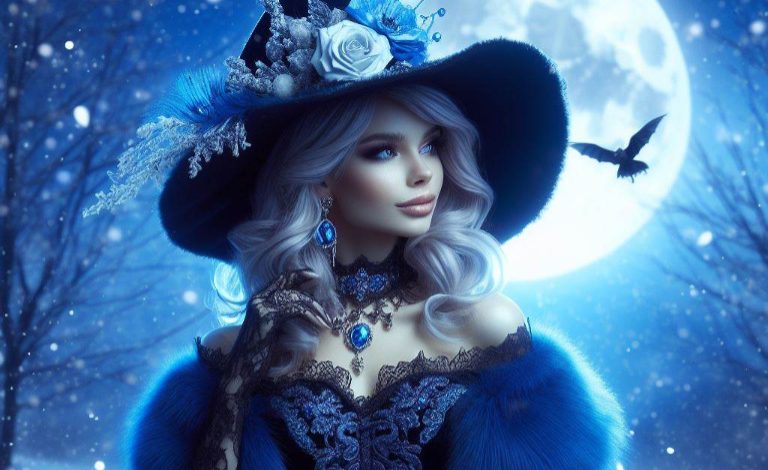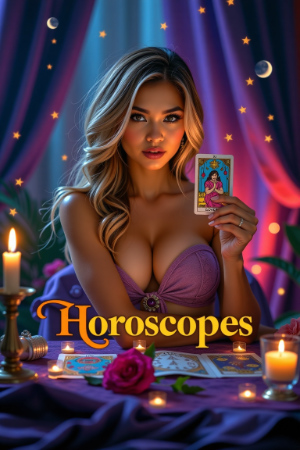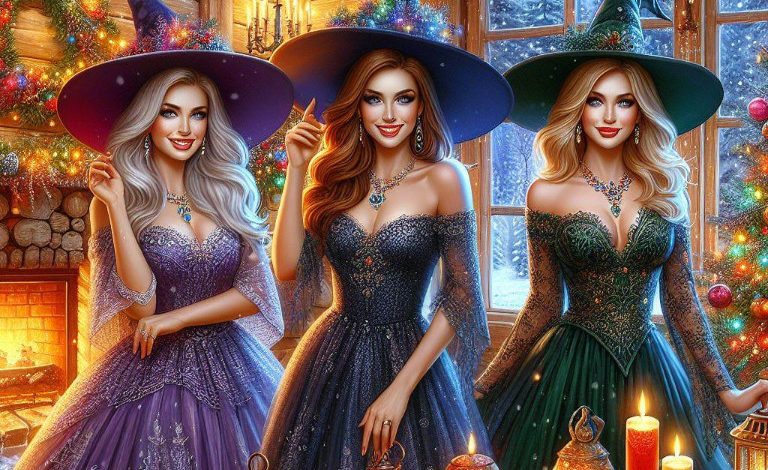
The 12 Days of Yule is a festive celebration that honors the winter solstice and the rebirth of the sun. It is a time to connect with the gods and goddesses, the ancestors and the spirits, the nature and the magic of this season. It is also a time to reflect on the past year and prepare for the new one.
In this chapter, you will learn about the origins and meanings of the 12 Days of Yule, and how to celebrate each day with rituals, activities, crafts, and foods. You will discover the traditions and customs of the ancient peoples who observed this festival, and how to adapt them to your modern lifestyle. Whether you are new to paganism or a seasoned practitioner, you will find something to enrich your Yule experience and bring joy and light to your winter days.
About yule
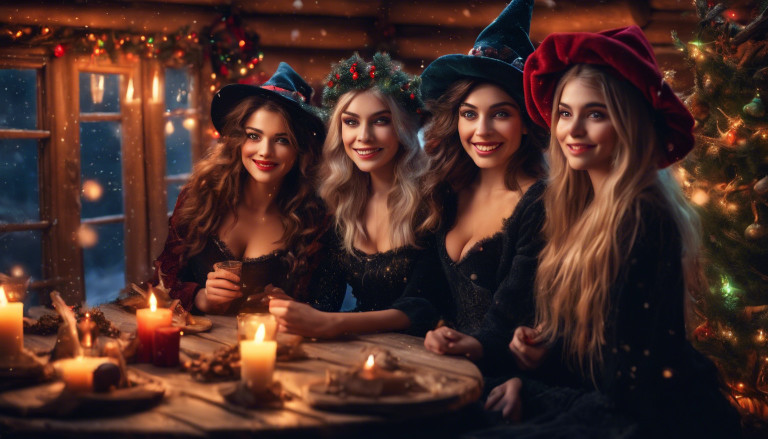
The word Yule comes from the Old Norse j?l, which was the name of a winter month in the ancient Germanic calendar. Later, it became ge?l in Old English and then Yule in modern English. It referred to a special festival that was celebrated in Scandinavia and other parts of Europe by the pagan peoples, who honored the gods, the ancestors, and the spirits of nature during the winter solstice.
Around the 900s, when most of Scandinavia converted to Christianity, the pagan festival of Yule was merged with the Christian celebration of the birth of Jesus, which was also held around the same time. This was done to make the transition to the new faith easier and more appealing for the people. The new hybrid celebration spread to other parts of the world, and today, Yule and Yuletide are used as synonyms for Christmas and the Christmas season.
However, Yule and Christmas are not exactly the same. They have different origins, meanings, and traditions, and they can be celebrated in different ways. Some people prefer to follow the pagan customs of Yule, such as lighting a Yule log, honoring the gods and goddesses, and making offerings to the spirits. Others prefer to follow the Christian customs of Christmas, such as decorating a Christmas tree, singing carols, and exchanging gifts. And some people like to combine elements of both, creating their own unique way of celebrating the winter solstice and the rebirth of the sun.
What are the 12 days of Yule?
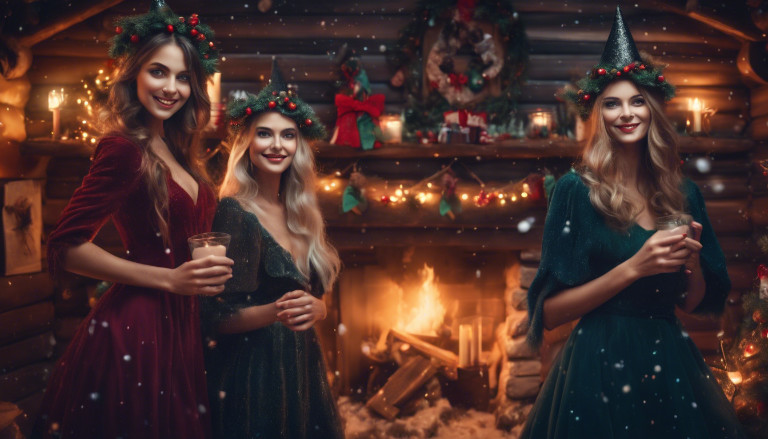
The 12 days of Yule are a festive celebration that honors the winter solstice and the rebirth of the sun. They are based on the ancient pagan festival that was observed by the Germanic and Celtic peoples of Europe. Depending on the calendar, the 12 days of Yule can start and end on different dates, but they usually span from late December to early January. For some people, the 12 days of Yule are synonymous with the 12 days of Christmas, which begin on December 25 and end on January 5. For others, the 12 days of Yule are a separate and unique holiday that follows its own traditions and customs.
How to Celebrate The 12 Days of Yule
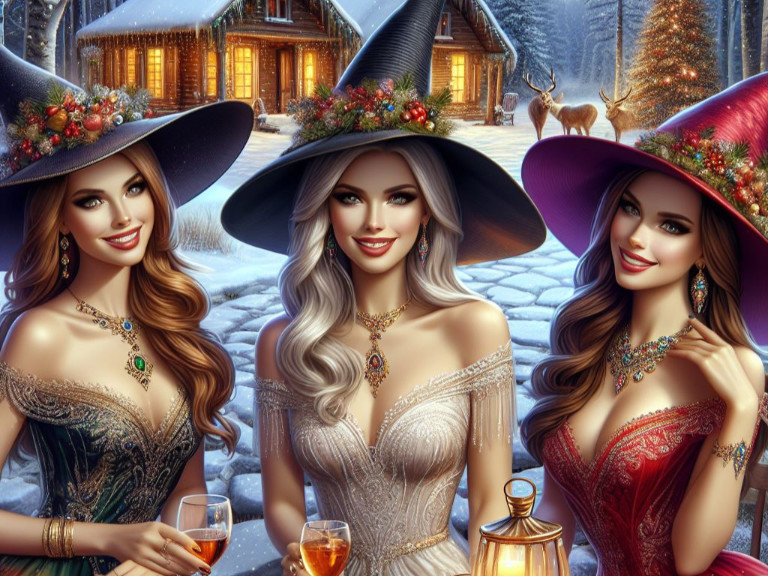
The 12 Days of Yule is a pagan holiday that celebrates the winter solstice and the rebirth of the sun. It is also a time to honor the gods and goddesses, the ancestors, and the spirits of nature. Here are some ways to celebrate each day of Yule, based on some of the traditions and customs of the ancient peoples who observed this festival.
First Day – December 20
The first day of Yule is also known as Mother’s Night, and it is a day to honor the female ancestors and the goddesses of fertility, protection, and wisdom. Some of the goddesses that are associated with this day are Frigg, Freyja, Holda, and Berchta. You can celebrate this day by:
- Setting up an altar with candles, incense, pictures, and symbols of your female ancestors and the goddesses you want to honor. You can also offer them food, drink, and gifts that they would like.
- Performing a ritual to invoke the goddesses and the ancestors, and ask for their blessings and guidance for the new year. You can also thank them for their presence and support in your life, and share your hopes and dreams with them.
- Doing some divination, such as tarot, runes, or oracle cards, to get some insight and advice from the goddesses and the ancestors. You can also ask them questions about your past, present, and future, and listen to their messages.
- Making some crafts, such as knitting, weaving, sewing, or spinning, to honor the goddesses and the ancestors who were skilled in these arts. You can also make some gifts for your loved ones, or donate some of your creations to a charity or a shelter.
Second Day – December 21
The second day of Yule is the winter solstice, the shortest day and the longest night of the year. It is also the day when the sun is reborn, and the days start to get longer and brighter. This is a day to celebrate the light, the fire, and the sun. Some of the gods and goddesses that are associated with this day are Odin, Thor, Balder, Sunna, and Sol. You can celebrate this day by:
- Lighting a Yule log, a large oak log that is decorated with evergreens, holly, mistletoe, and candles. You can also carve runes or symbols on the log, and sprinkle it with salt, herbs, and oils. The Yule log is burned in a fireplace or a bonfire, and it represents the return of the sun and the warmth. You can also save some of the ashes and use them to fertilize your plants or protect your home.
- Performing a ritual to welcome the sun and the fire, and ask for their blessings and energy for the new year. You can also thank them for their light and warmth, and share your gratitude and joy with them.
- Singing songs, telling stories, and playing games that celebrate the sun and the fire. You can also exchange gifts, make wishes, and toast to the sun and the fire.
- Making some sun and fire crafts, such as candles, lanterns, sun catchers, or sun wheels. You can also make some sun and fire foods, such as gingerbread, fruitcake, mulled wine, or cider.
Third Day – December 22
The third day of Yule is a day to honor the triple goddess, the three aspects of the divine feminine: the maiden, the mother, and the crone. The triple goddess represents the cycles of life, death, and rebirth, and the phases of the moon. Some of the goddesses that are associated with this day are Brigid, Hecate, Morrigan, and the Norns. You can celebrate this day by:
- Setting up an altar with candles, incense, flowers, and symbols of the triple goddess and the moon. You can also offer them food, drink, and gifts that they would like.
- Performing a ritual to invoke the triple goddess and the moon, and ask for their blessings and wisdom for the new year. You can also thank them for their guidance and power in your life, and share your challenges and achievements with them.
- Doing some magic, such as spells, charms, or potions, to harness the energy of the triple goddess and the moon. You can also ask them for help with your goals, desires, and needs, and listen to their suggestions.
- Making some triple goddess and moon crafts, such as jewelry, dolls, masks, or wreaths. You can also make some triple goddess and moon foods, such as cheese, milk, honey, or moon cakes.
Fourth Day – December 23
The fourth day of Yule is a day to honor the ancestors, the spirits of the departed who have influenced our lives and shaped our heritage. The ancestors can be our blood relatives, our spiritual mentors, or our cultural heroes. Some of the traditions and customs that are associated with this day are the Dísablót, the Feast of the Dead, and the Wild Hunt. You can celebrate this day by:
- Setting up an altar with candles, incense, skulls, bones, and symbols of the ancestors. You can also offer them food, drink, and gifts that they would like.
- Performing a ritual to invoke the ancestors and the spirits of the dead, and ask for their blessings and protection for the new year. You can also thank them for their legacy and wisdom in your life, and share your memories and stories with them.
- Doing some genealogy, such as researching your family tree, visiting your ancestral graves, or creating a family album. You can also honor your ancestors by learning more about their culture, language, or crafts.
- Making some ancestor crafts, such as masks, dolls, puppets, or portraits. You can also make some ancestor foods, such as bread, soup, pie, or cookies.
Fifth Day – December 24
The fifth day of Yule is a day to honor the animals, the creatures of the earth, air, and water who share this world with us and provide us with food, companionship, and inspiration. The animals can be our pets, our livestock, our totems, or our spirit guides. Some of the traditions and customs that are associated with this day are the Julbock, the Yule Cat, and the Yule Goat. You can celebrate this day by:
- Setting up an altar with candles, incense, feathers, fur, and symbols of the animals. You can also offer them food, drink, and gifts that they would like.
- Performing a ritual to invoke the animals and the spirits of nature, and ask for their blessings and harmony for the new year. You can also thank them for their beauty and diversity in your life, and share your appreciation and respect with them.
- Doing some animal care, such as feeding, grooming, playing, or cuddling with your pets or livestock. You can also honor the animals by adopting, fostering, or donating to an animal shelter or a wildlife sanctuary.
- Making some animal crafts, such as ornaments, toys, collars, or costumes. You can also make some animal foods, such as treats, biscuits, cakes, or candy.
Sixth Day – December 25
The sixth day of Yule is a day to honor the gods and goddesses, the divine beings who rule over the realms of existence and manifest the forces of nature and the aspects of life. The gods and goddesses can be from any pantheon or tradition that you follow or resonate with. Some of the traditions and customs that are associated with this day are the Æsirblót, the Saturnalia, and the Dies Natalis Solis Invicti. You can celebrate this day by:
- Setting up an altar with candles, incense, statues, and symbols of the gods and goddesses. You can also offer them food, drink, and gifts that they would like.
- Performing a ritual to invoke the gods and goddesses and ask for their blessings and favor for the new year. You can also thank them for their presence and power in your life, and share your devotion and love with them.
- Doing some meditation, prayer, or chanting to connect with the gods and goddesses and receive their guidance and inspiration. You can also honor the gods and goddesses by studying their myths, symbols, or attributes.
- Making some god and goddess crafts, such as crowns, masks, jewelry, or banners. You can also make some god and goddess foods, such as wine, cheese, nuts, or fruits.
Seventh Day – December 26
The seventh day of Yule is a day to honor the elves, the fairies, the dwarves, and the other hidden folk who dwell in the realms of magic and mystery. The hidden folk are the guardians of nature, the keepers of secrets, and the makers of wonders. Some of the traditions and customs that are associated with this day are the Elf Feast, the Fairy Ring, and the Dwarf Gift. You can celebrate this day by:
- Setting up an altar with candles, incense, crystals, and symbols of the hidden folk. You can also offer them food, drink, and gifts that they would like.
- Performing a ritual to invoke the hidden folk and ask for their blessings and friendship for the new year. You can also thank them for their magic and mischief in your life, and share your curiosity and admiration with them.
- Doing some exploration, such as walking in the woods, visiting a cave, or finding a hidden spot. You can also honor the hidden folk by leaving them offerings, singing to them, or playing with them.
- Making some hidden folk crafts, such as fairy houses, elf hats, dwarf hammers, or fairy wings. You can also make some hidden folk foods, such as cookies, candy, nuts, or berries.
Eighth Day – December 27
The eighth day of Yule is a day to honor the spirits of the land, the beings who inhabit and animate the natural features of the earth. The spirits of the land are the essence of the mountains, rivers, forests, fields, and stones. Some of the traditions and customs that are associated with this day are the Landvættirblót, the Stone Circle, and the Sacred Grove. You can celebrate this day by:
- Setting up an altar with candles, incense, plants, and symbols of the spirits of the land. You can also offer them food, drink, and gifts that they would like.
- Performing a ritual to invoke the spirits of the land and ask for their blessings and cooperation for the new year. You can also thank them for their support and beauty in your life, and share your respect and reverence with them.
- Doing some gardening, such as planting, pruning, weeding, or harvesting. You can also honor the spirits of the land by cleaning, blessing, or decorating their places of power.
- Making some land spirit crafts, such as wreaths, garlands, baskets, or sculptures. You can also make some land spirit foods, such as bread, soup, salad, or tea.
Ninth Day – December 28
The ninth day of Yule is a day to honor the ancestors of the spirit, the people who have inspired us and influenced us in our spiritual path and practice. The ancestors of the spirit can be our teachers, mentors, heroes, or role models. They can be from any time, place, or tradition that we feel connected to. Some of the traditions and customs that are associated with this day are the Ancestor Feast, the Hall of Heroes, and the Shrine of Inspiration. You can celebrate this day by:
- Setting up an altar with candles, incense, books, and symbols of the ancestors of the spirit. You can also offer them food, drink, and gifts that they would like.
- Performing a ritual to invoke the ancestors of the spirit and ask for their blessings and guidance for the new year. You can also thank them for their inspiration and influence in your life, and share your admiration and gratitude with them.
- Doing some learning, such as reading, writing, listening, or speaking. You can also honor the ancestors of the spirit by studying their works, following their examples, or sharing their stories.
- Making some spirit ancestor crafts, such as portraits, bookmarks, journals, or cards. You can also make some spirit ancestor foods, such as cake, chocolate, coffee, or wine.
Tenth Day – December 29
The tenth day of Yule is a day to honor the spirits of the home, the beings who dwell in and protect our household and family. The spirits of the home are the hearth, the door, the well, and the ancestors. Some of the traditions and customs that are associated with this day are the House Blessing, the Door Warding, and the Well Offering. You can celebrate this day by:
- Setting up an altar with candles, incense, water, and symbols of the spirits of the home. You can also offer them food, drink, and gifts that they would like.
- Performing a ritual to invoke the spirits of the home and ask for their blessings and peace for the new year. You can also thank them for their comfort and security in your life, and share your affection and loyalty with them.
- Doing some cleaning, organizing, repairing, or decorating of your home. You can also honor the spirits of the home by making it cozy, welcoming, and festive.
- Making some home spirit crafts, such as wreaths, door hangers, coasters, or placemats. You can also make some home spirit foods, such as stew, pie, pudding, or cider.
Eleventh Day – December 30
The eleventh day of Yule is a day to honor the spirits of the sky, the beings who inhabit and rule over the celestial bodies and the weather. The spirits of the sky are the sun, the moon, the stars, and the clouds. Some of the traditions and customs that are associated with this day are the Sun Salutation, the Moon Meditation, and the Star Gazing. You can celebrate this day by:
- Setting up an altar with candles, incense, mirrors, and symbols of the spirits of the sky. You can also offer them food, drink, and gifts that they would like.
- Performing a ritual to invoke the spirits of the sky and ask for their blessings and inspiration for the new year. You can also thank them for their illumination and guidance in your life, and share your awe and wonder with them.
- Doing some observation, such as watching the sunrise, the sunset, the moon phases, or the weather patterns. You can also honor the spirits of the sky by learning more about their names, stories, or meanings.
- Making some sky spirit crafts, such as sun catchers, moon lamps, star ornaments, or cloud pillows. You can also make some sky spirit foods, such as pancakes, cheese, popcorn, or marshmallows.
Twelfth Day – December 31
The twelfth day of Yule is the last day of the old year and the eve of the new year. It is a day to reflect on the past, present, and future, and to celebrate the cycle of life, death, and rebirth. Some of the traditions and customs that are associated with this day are the New Year’s Eve, the New Year’s Resolutions, and the New Year’s Day. You can celebrate this day by:
- Setting up an altar with candles, incense, clocks, and symbols of the old and new year. You can also offer them food, drink, and gifts that they would like.
- Performing a ritual to bid farewell to the old year and welcome the new year, and ask for their blessings and prosperity for the new year. You can also thank them for their lessons and opportunities in your life, and share your hopes and plans with them.
- Doing some review, such as writing a journal, making a collage, or creating a timeline of your achievements, challenges, and changes in the past year. You can also honor the old and new year by setting some goals, intentions, or resolutions for the next year.
- Making some old and new year crafts, such as calendars, journals, vision boards, or charms. You can also make some old and new year foods, such as cake, champagne, lentils, or grapes.
Yule Deities
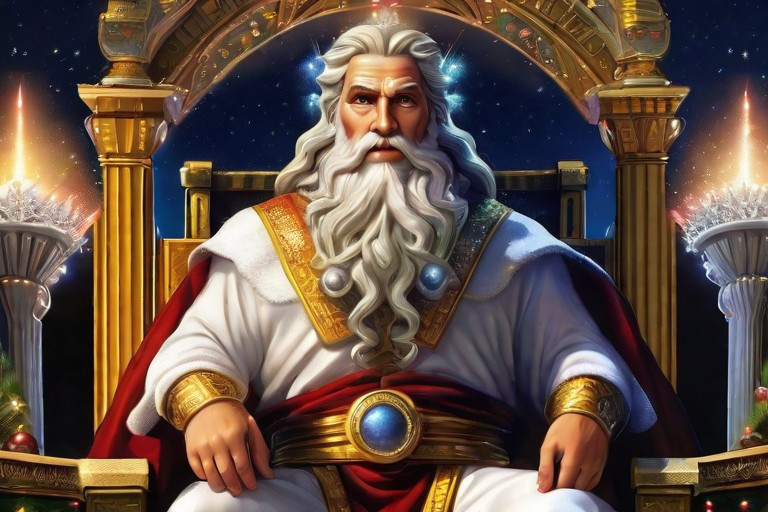
Yule is a festival that honors the cycle of life, death, and rebirth, and the return of the sun after the longest night of the year. During this time, many deities are revered and invoked for their blessings and protection. Depending on the region and tradition, different gods and goddesses are associated with Yule, but some of the most common ones are:
- Odin: The chief god of the Norse pantheon, he leads the Wild Hunt, a ghostly procession of the dead, across the sky. He is also the god of wisdom, war, poetry, and magic, and the father of many other gods.
- Thor: The son of Odin and the god of thunder, he wields the mighty hammer Mjolnir and fights against the frost giants who threaten the world. He is also the god of strength, courage, and justice.
- Frigg/Freyr: Frigg is the wife of Odin and the goddess of motherhood, marriage, and domesticity. She is also a seeress who knows the fate of all beings. Freyr is her brother and the god of fertility, abundance, and peace. He rules over the land of the elves and the seasons.
- Goddess Brechta: A Germanic goddess of spinning, weaving, and domestic arts, she visits homes during Yule and rewards or punishes the women for their work. She is also associated with witchcraft and the underworld.
- Ullr and Skadhi: Ullr is the son of Sif and the stepson of Thor. He is the god of hunting, archery, skiing, and winter sports. Skadhi is his wife and the goddess of mountains, snow, and wilderness. She is also a skilled huntress and warrior.
- Njord: The father of Freyr and Freyja, he is the god of the sea, wind, and wealth. He grants prosperity and good fortune to sailors, fishermen, and merchants. He is also the god of hospitality and friendship.
- Balder: The son of Odin and Frigg, he is the god of light, joy, and purity. He is beloved by all the gods and mortals, but he is doomed to die by a mistletoe dart. His death triggers the events of Ragnarok, the end of the world, but he will be reborn in the new world.
- Sunna: The goddess of the sun, she drives a chariot across the sky every day, chased by a wolf who wants to devour her. She is the source of life and warmth, and her return after the winter solstice is celebrated as the rebirth of the sun.
- Mani: The god of the moon, he is the brother of Sunna and also drives a chariot across the sky, followed by another wolf. He is the lord of the night and the keeper of time. He also influences the tides and the phases of the moon.
- Nott: The goddess of the night, she is the mother of Dagr, the god of day, and the grandmother of Sunna and Mani. She rides a black horse across the sky, bringing darkness and rest to the world. She is also the goddess of dreams and visions.
- Dagr: The god of the day, he is the son of Nott, the goddess of night, and the father of Sunna and Mani. He rides a white horse across the sky, bringing light and wakefulness to the world. He is also the god of dawn and new beginnings.
Yule Crystals
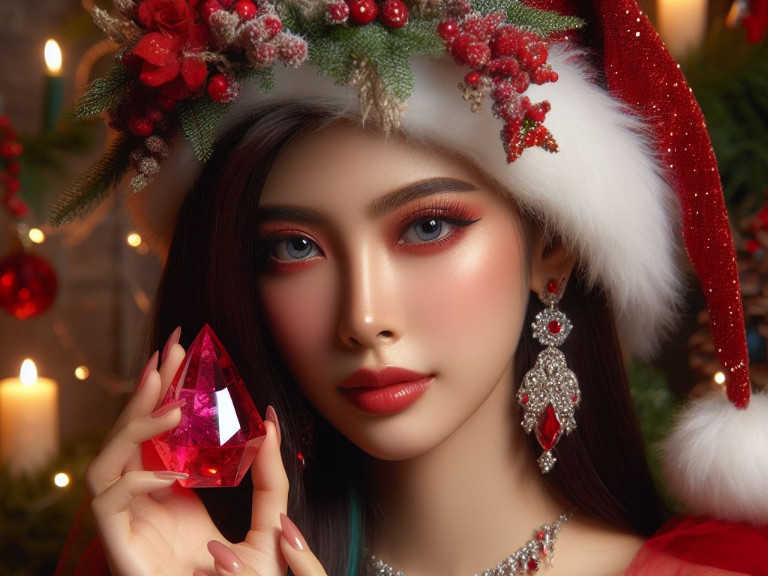
Yule is a magical time of the year, when we celebrate the winter solstice and the return of the light. Crystals can enhance our Yule rituals and decorations, as they resonate with the energy and symbolism of this season. Some of the most popular crystals for Yule are:
- Bloodstone: This dark green stone with red spots is a powerful healer and protector. It helps us overcome fear and challenges, and inspires us to be brave and loving.
- Ruby: This bright red stone is a symbol of passion and prosperity. It attracts good luck and abundance, and helps us manifest our desires for the new year.
- Garnet: This fiery red stone is a source of vitality and creativity. It ignites our inner fire and sparks our imagination. It was also used as a talisman by ancient warriors and travelers.
- Black Onyx: This black stone is a grounding and cleansing stone. It helps us release negative emotions and thoughts, and gain clarity and focus. It also deepens our connection to our inner self and our guides.
- Azurite: This blue stone is a stone of mystery and magic. It enhances our intuition and vision, and helps us communicate with our higher self and our spirit allies. It also opens our third eye and crown chakras.
- Sugilite: This purple stone is also known as the healer’s stone. It balances our mind, body, and spirit, and helps us heal from physical and emotional wounds. It also aligns us with our soul purpose and our divine plan.
- Snow Quartz: This white stone is a stone of purity and peace. It calms and soothes our energy, and helps us purify our aura and our environment. It also connects us to the spirit of winter and the snow.
Yule sacred plants & Herbs
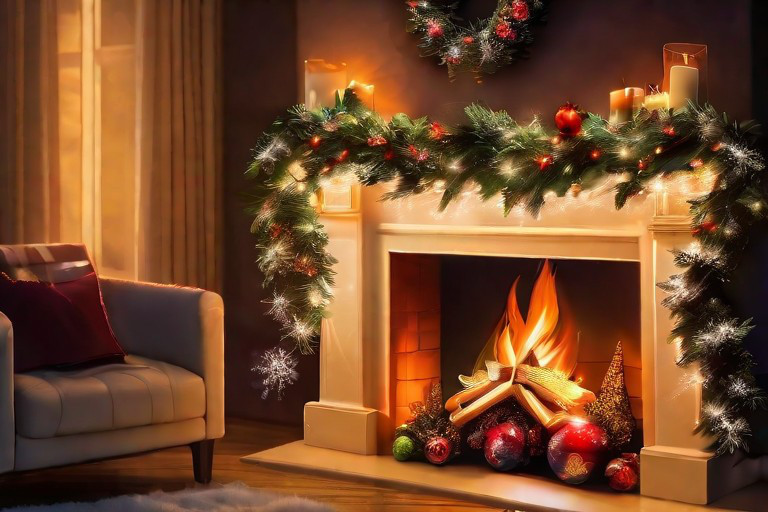
Plants are an essential part of Yule, the pagan celebration of the winter solstice and the rebirth of the sun. They are used for decoration, ritual, and magic, and they embody the spirit and symbolism of this season. Some of the most common plants for Yule are:
- Mistletoe: This parasitic plant grows on trees and bridges the gap between heaven and earth. It represents the feminine principle and the fertility of the Mother Goddess. The druids revered it as a sacred plant and used it for healing and protection. The white berries symbolize the seed of the Forest King or Oak King, who rules over the winter half of the year.
- Holly: This evergreen tree with sharp leaves and red berries represents the masculine principle and the Holly King, who battles with the Oak King for the sovereignty of the land. The Vikings adorned their homes with holly to bring hope and ward off evil. The red berries signify the blood and vitality of the Holly King.
- Evergreens: These are the trees that stay green throughout the year, even in the coldest and darkest days. They symbolize the power of life over death, and the promise of renewal and rebirth. The pre-Christian Norsemen used evergreens to protect themselves from the winter spirits and to invite the sun to return.
Yule Colors
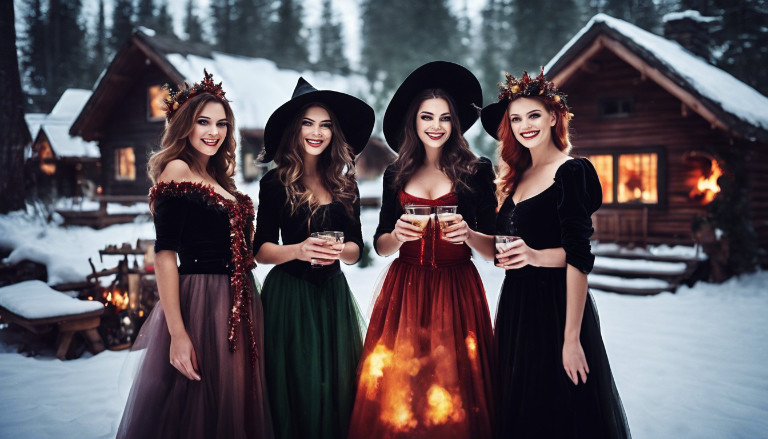
Yule is a festive celebration that honors the winter solstice and the rebirth of the sun. The colors of Yule reflect the spirit and symbolism of this season, and they can be used for decoration, ritual, and magic. Some of the most common colors for Yule are:
- Red: This fiery color is a symbol of prosperity and passion. It attracts good luck and abundance, and helps us manifest our desires for the new year. It is also the color of the Holly King, the ruler of the winter half of the year, who battles with the Oak King for the sovereignty of the land.
- Green: This earthy color is a symbol of life, rebirth, and renewal. It represents the power of nature and the promise of spring. It is also the color of the Oak King, the ruler of the summer half of the year, who defeats the Holly King and brings back the light.
- White: This pure color is a symbol of hope and purity. It represents the new light that is born after the longest night of the year, and the fresh start that awaits us. It is also the color of snow, which covers the earth and cleanses it of the old.
- Silver: This shiny color is a symbol of the moon, the celestial body that rules the night and the tides. It represents the feminine principle and the intuition. It is also the color of the stars, which guide us and inspire us with their beauty and mystery.
- Gold: This bright color is a symbol of the sun, the celestial body that rules the day and the seasons. It represents the masculine principle and the energy. It is also the color of fire, which warms us and protects us from the cold and the dark.
Yule Symbols
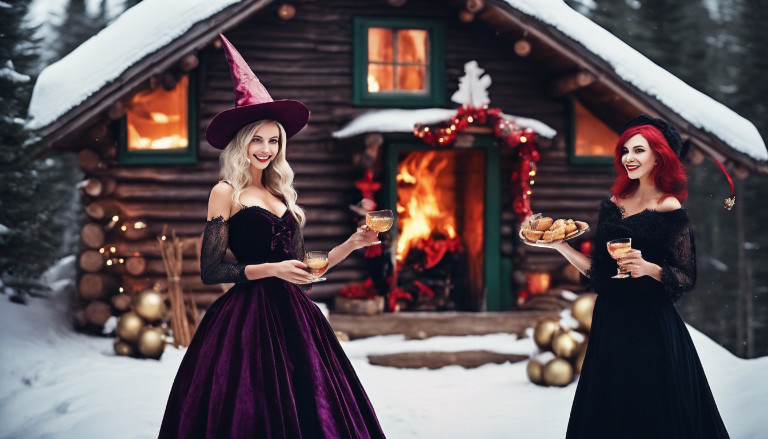
Yule Log
One of the most important symbols of Yule is the Yule Log, a large oak tree that was cut down and brought into the home before the winter solstice. The Yule Log was placed in the fireplace with the trunk facing inward, and lit with a piece of the previous year’s log. It was kept burning for the entire 12 days of Yule, symbolizing the warmth and light of the sun that was returning. The Yule Log was also a tribute to Thor, the god of thunder and lightning, who protected the people from evil spirits and misfortune. The faster the log burned, the sooner the sun would come back. The ashes and the leftover log were saved and used for various purposes, such as fertilizing the crops, healing wounds, or warding off storms and diseases.
Yule Goat
Another symbol of Yule is the Yule Goat, a goat-shaped figure that has different meanings and roles in different regions. One of the most common origins of the Yule Goat is the legend of Thor, who rode across the sky in a chariot pulled by two goats, Tanngrisnir and Tanngnjóstr. The Yule Goat was a representation of these goats, and a sign of Thor’s presence and power. In some areas, the Yule Goat was made of straw and decorated with ribbons and bells, and hung on the door or the tree as a decoration. In other areas, the Yule Goat was a spirit of the harvest, who brought gifts and blessings to the people. Sometimes, the Yule Goat was a person dressed in a goat costume, who went from house to house, singing, dancing, and asking for treats.
Yule Pig
The Yule pig or Yule boar was a sacrificial animal associated with the Norse god Freyr, who was the god of fertility, abundance, and peace. The pig was a symbol of his power and his sacred animal. The Yule pig was either roasted and eaten at the feast, or offered to the gods at a temple or sacred grove. Sometimes, a loaf of bread shaped like a pig was used instead of a real animal.
Old Man Winter
Old Man Winter is a personification of winter, often depicted as an old man with a white beard and wintry clothes. He is sometimes seen as a representation of Odin, the chief god of the Norse pantheon, who led the Wild Hunt, a ghostly procession of the dead, across the sky during the winter. He is also sometimes associated with Thor, the god of thunder and lightning, who protected the people from the frost giants and the winter spirits.
A Yule Wreath
A Yule wreath is a circular garland made of evergreens, such as pine, fir, juniper, or cedar, and decorated with berries, pine cones, nuts, ribbons, or other ornaments. It is a symbol of the wheel of the year, the eternal cycle of life, and the rebirth of the sun. It is also a way to bring some greenery and color into the home during the dark and cold season. A Yule wreath can be hung on a door, a wall, a window, or a fireplace, or placed on a table as a centerpiece.
Wassailing
Wassailing is a custom of singing and drinking to the health of people, animals, or plants, especially during the winter solstice. The word wassail comes from the Old English greeting waes hael, meaning “be well” or “be in good health”. The wassail drink was a spiced ale, wine, or cider, served hot in a large bowl or cup. Wassailing can be divided into two types: the house-visiting wassail, where people go from door to door, singing carols and offering wassail in exchange for gifts or goodwill; and the orchard-visiting wassail, where people go to the orchards, singing and reciting incantations to the trees, pouring wassail on their roots, and making noise to scare away evil spirits and encourage a good harvest.
Yule Tree
The Yule tree was a sacred symbol of the Norse people, who believed it represented the Tree of Life or Yggdrasil, the cosmic tree that connected the nine worlds. They would choose an evergreen tree, such as a pine, fir, or spruce, and bring it into their home or hall before the winter solstice. They would decorate it with various items, such as gifts, pinecones, berries, and runes, to express their wishes and prayers for the coming year. Sometimes, they would also hang corn and coins on the tree, to symbolize their hope for a plentiful and prosperous harvest.
Bells
The Norse people also used bells as a way of protecting themselves and their homes from the dangers of the winter solstice, when they believed that the veil between the worlds was thin and that strange and evil creatures roamed the earth. They would tie bells to their doors, windows, and fireplaces, and ring them every morning to scare away the demons and spirits that might harm them. The bells also served as a reminder of the return of the sun and the light, and as a way of celebrating the new dawn and the new year.
Elves
Elves were another important feature of the Yule celebrations, as they were seen as the guardians and allies of the sun, which they believed lived in the land of the elves or Álfheimr. The Norse people would honor the elves and ask for their help in bringing back the sun and the warmth. They would include elvish symbols or decorations in their Yule tree, such as stars, candles, and bells, to attract the elves and please them. They would also leave offerings of food and drink for the elves, who were thought to bring gifts and blessings to the people who treated them well.
Final Musings
The 12 days of Yule are a wonderful way to celebrate the winter season and the cycle of life. They are a time to honor the different aspects of the divine, the natural, and the human worlds, and to connect with them in meaningful ways. They are also a time to reflect on the past year and to look forward to the new one, with hope, joy, and gratitude.
Whether you follow the pagan, celtic, or nordic traditions, or you create your own blend of customs and practices, you can make the 12 days of Yule a special and sacred time for yourself and your loved ones. You can find inspiration and guidance from the ancient sources, the modern resources, or your own intuition. You can also find community and support from other people who share your beliefs and values. The 12 days of Yule are a gift that you can give to yourself and to the world, a gift of light, love, and magic.


